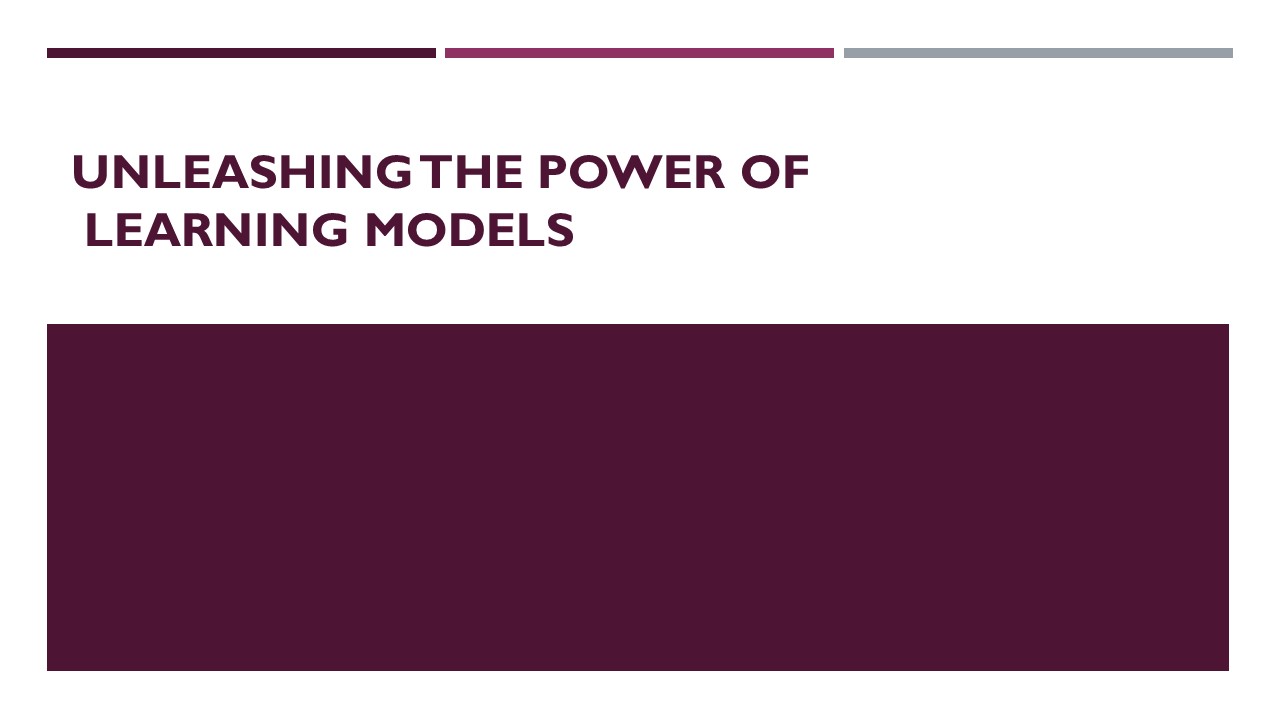learning model - PowerPoint PPT Presentation
Title:
learning model
Description:
A learning model refers to a framework or theoretical approach that outlines the principles, strategies, and methods used to facilitate the process of learning. Learning models serve as a guide for educators, instructional designers, and policymakers to design and implement effective educational experiences for learners. – PowerPoint PPT presentation
Number of Views:5
Title: learning model
1
Unleashing the Power of Learning Models
2
Why Learning Models are the Future of Education
- Welcome to our presentation on why learning
models are the future of education! As we all
know, education is constantly evolving, and new
approaches to teaching and learning are emerging
all the time. One of the most exciting
developments in recent years has been the rise of
learning models, which offer a more personalized,
engaging, and effective way of learning. In this
presentation, we'll explore what learning models
are, why they're gaining popularity, and how they
can benefit students and educators alike. - So why are learning models becoming so popular?
Simply put, they work! By tailoring the learning
experience to each individual student's needs,
interests, and abilities, learning models can
help students learn faster, retain information
better, and stay engaged and motivated throughout
the learning process. And with advances in
technology, it's easier than ever to implement
these models in a variety of educational
settings.
3
What is a Learning Model?
- A learning model is a framework that outlines the
process of acquiring knowledge or skills. It
provides a structure for organizing educational
activities and helps educators design effective
instructional strategies. Learning models can be
used in various settings, including traditional
classrooms, online courses, and self-directed
learning. - One popular learning model is the flipped
classroom, where students watch lecture videos at
home and complete homework assignments in class.
Another example is project-based learning, where
students work on real-world projects to develop
practical skills. Other learning models include
inquiry-based learning, game-based learning, and
personalized learning.
4
Benefits of Learning Models
- Learning models offer a range of benefits for
students and educators alike. By personalizing
the learning experience, students can work at
their own pace and focus on areas where they need
the most help. This leads to increased engagement
and motivation, as students are more invested in
their own learning process. In addition, learning
models can help improve outcomes by providing
real-time feedback and assessment, allowing
teachers to adjust their teaching strategies
accordingly. - For educators, learning models offer a way to
streamline administrative tasks and free up time
for more meaningful interactions with students.
With automated grading and assessments, teachers
can spend less time on paperwork and more time on
teaching and mentoring. Furthermore, learning
models can help teachers identify areas where
students are struggling, allowing them to provide
targeted support and interventions.
5
Implementing Learning Models
- Implementing learning models can be a daunting
task, but it is crucial for the future of
education. One practical tip is to start small
and gradually introduce new models into the
classroom or online platform. This allows for
experimentation and adjustment before fully
committing to a new approach. - Another important consideration is teacher
training. Educators need to understand how to
effectively use learning models and how they can
best support their students. This may require
additional professional development opportunities
or resources to ensure success.
6
Challenges and Limitations
- While learning models offer many benefits, there
are also several challenges and limitations to
their use in education. One of the biggest
challenges is the need for teacher training.
Teachers must be trained on how to effectively
implement learning models in their classrooms and
adapt their teaching styles to accommodate this
new approach to learning. - Another limitation of learning models is the
potential for technology to replace human
interaction. While technology can provide
personalized learning experiences and improve
outcomes, it cannot replace the value of
face-to-face interaction between students and
teachers. It is important to find a balance
between technology and human interaction in order
to create a well-rounded educational experience.
7
The Future of Learning Models
- As we move into the future, learning models will
undoubtedly play an increasingly important role
in education. With the rapid pace of
technological advancement, it's clear that
traditional approaches to teaching and learning
are no longer sufficient. Learning models offer a
way to personalize education and provide students
with the skills they need to succeed in a rapidly
changing world. - In the coming years, we can expect to see more
schools and universities embracing learning
models, as well as the development of new models
that take advantage of emerging technologies such
as artificial intelligence and virtual reality.
While there will undoubtedly be challenges along
the way, the potential benefits of these new
approaches to education are too great to ignore. - Reference
- Blended learning and its models- Way to enhance
the learning experience - Enhancing Art and Media Engagement through
Learning Models































